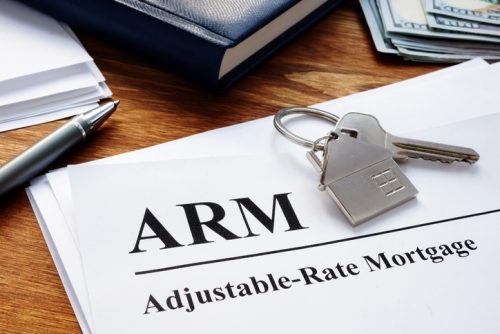There are numerous loan factors to consider while getting a mortgage. One of the most important decisions is whether to get a fixed or adjustable-rate mortgage loan. ARMs can be enticing in today’s rising-rate climate because of their lower beginning rates, but they come with significant risk.
Each loan type has advantages and disadvantages. So, your decision should be guided by your budget, housing demands, and financial risk tolerance. Let’s see the definition of an adjustable rate mortgage (ARM) and the different types including the 5/1 and 5/6 ARMs
What is an Adjustable-rate Mortgage (ARM) Loan?
An adjustable-rate mortgage (ARM) is a loan in which the interest rate changes on a regular basis, typically based on a predetermined index. An ARM loan may contain an initial fixed-rate period of 5 to 10 years. Once the initial fixed period expires, the interest rate may be changed (adjusted) each year thereafter. For example, with a 5/1 ARM loan for a 30-year term, your interest rate would be fixed for the first 5 years before fluctuating up or down each year for the next 25 years.
How Does an Adjustable-Rate Mortgage Work?
ARMs are long-term home loans that have two distinct phases, known as the fixed period and the adjustable period.
- Fixed period: First, there is an initial fixed-rate period (usually the first 5, 7, or 10 years of the loan) during which your interest rate will not fluctuate.
- Adjustment period: After that, your interest rate may rise or fall based on changes in the benchmark. (More on benchmarks coming shortly.)
As an example, suppose you take up a 30-year ARM with a 5-year fixed duration. This would result in a fixed interest rate for the first five years of the loan. After then, your interest rate may fluctuate for the remaining 25 years of the loan.
Nonconforming ARMs vs. Conforming ARMs
As you research your ARM choices, you will come across conforming and non-conforming loans.
Conforming loans are mortgages that meet certain criteria and can be sold to Fannie Mae and Freddie Mac. If lenders follow their criteria, they can sell mortgages they originate to these government-sponsored enterprises for repackaging on the secondary mortgage market.
If a loan does not fulfill these precise requirements, it is classified as nonconforming. However, before entering into a nonconforming loan, be aware of the potential dangers! Although there are valid reasons why borrowers may require a nonconforming mortgage. While the majority of nonconforming mortgage originators are trustworthy, many are not. If you’re thinking about getting a nonconforming ARM, make sure you read the fine print on rate resets carefully and understand how they function.
One implication is that FHA and VA ARMs are nonconforming under Fannie Mae and Freddie Mac guidelines, yet they have the full backing of the US government. If you have the support of the federal government, you may feel more at ease picking one of these loans if they are available to you.
Rate Caps And Adjustable Rate Mortgage (ARM) Rates
A number of things influence mortgage rates. Personal elements such as your credit score are included, as are the broader effects of economic conditions. You may initially encounter a teaser rate to attract you with an extremely low rate that will vanish at some time during the loan term.
The benchmark specified in the contract serves as the basis for an ARM’s rate. The contract, for example, might identify the US Treasury or the secured overnight finance rate (SOFR) as a rate benchmark. The benchmark will essentially act as the starting point for any reset computations.
The United States Treasury and SOFR rates are among the lowest available for short-term loans to their most creditworthy clients, which are often governments and major enterprises. Other consumer loans are priced at a margin, or markup, to these lowest feasible loan rates based on that benchmark.
The margin on your ARM is determined by your credit score and history, as well as a standard margin that recognizes mortgages are intrinsically riskier than the loans indexed by the benchmarks. The most creditworthy customers will pay close to the typical mortgage margin, and riskier loans will be marked up more from there.
The good news is that rate caps may be in place, indicating a maximum interest rate adjustment allowed during any given period of the ARM. As a result, each new rate modification will have more tolerable swings.
Adjustable-Rate Mortgage (ARM) Refinancing
In some cases, an ARM may be the best option. But what if your financial situation changes? To lock in more stability than an ARM can provide, you can refinance your ARM into a fixed-rate mortgage.
Fortunately, the procedure is relatively simple. You will take out a new loan to pay off the existing mortgage if you refinance. After then, you’ll begin repaying the new mortgage.
Because you’re applying for a new mortgage, you’ll need to go through many of the same steps you did when you first applied for a mortgage. Pay stubs, bank statements, and tax returns, for example, will very certainly be required.
With appealing interest rates on the market, now might be a good time to think about locking in a low rate for the life of your loan.
Fixed vs. Adjustable Rate Mortgage
As a prospective homebuyer, you will be able to pick between a fixed-rate mortgage and an adjustable-rate mortgage. So, what is the distinction between these mortgages?
A fixed-rate mortgage provides more certainty because the interest rate remains constant during the term of the loan. That implies your monthly mortgage payment will be fixed for the duration of the loan.
An ARM, on the other hand, may charge less interest during the introductory period, resulting in a reduced first monthly payment. However, after that initial term, changes in interest rates will have an impact on your payments. If interest rates fall, ARMs can become less expensive than fixed-rate mortgages; yet, if rates rise, ARMs can become significantly more expensive.
Types of Adjustable Rate Mortgage (ARM) Loans
There are various possible layouts to pick from if you are interested in an ARM. Here’s a deeper look at your alternatives.
#1. 5/1 AND 5/6 Adjustable Rate Mortgage
The interest rate on 5/1 and 5/6 adjustable rate mortgage loans is fixed for the first 5 years of the loan duration. The second number indicates how frequently the rate is adjusted after the first five years. The rate on a 5/1 adjustable rate mortgage varies once a year. The rate on a 5/6 ARM adjusts every 6 months. Rate limitations may also be applied with the loan.
So, what exactly is a rate cap? In the real estate industry, the word 5/1 (2/2/5) may be used to refer to a 5/1 adjustable rate mortgage.
The second set of numbers – 2/2/5 – pertains to rate cap details. These are some examples:
- The first “2” is the cap, or limit, on how much your initial reset can adjust your interest rate. In other words, after the initial 5-year introductory term, your ARM may adjust your interest rate by 2% in Year 6.
- Subsequent adjustment cap: The second “2” represents the maximum amount that subsequent rate resets can raise your interest rate. In general, the normal subsequent adjustment cap is 2%. This means that your interest rate might rise by as much as 2% in Year 7.
- The lifetime adjustment cap specifies how much the interest rate can rise in total throughout the life of the loan. In our case, the interest rate can only rise by 1% in Year 8 and thereafter: 5 percent (total lifetime cap) minus 2% (Year 1 adjustment) minus 2% (Year 2 adjustment) equals 1%
Read Also: Mortgage Calculator Refinance Guide: Overview, Comparisons, & All you need
Most ARMs have a lifetime adjustment cap of 5%, but there are greater lifetime caps that could cost you substantially more in the long run. If you’re thinking about getting an ARM, make sure you understand how rate cap quotes are prepared and how much your monthly payments could increase if interest rates rise.
#2. ARMS 7/1 AND 7/6
The 7/1 and 7/6 ARMs have a 7-year fixed rate. With a 30-year term, this would result in variable payments based on changing interest rates for the next 23 years after the initial fixed-rate period ends.
Remember that the interest rate may grow or fall, resulting in a greater or lower mortgage payment to cover your budget.
#3. ARMS 10/1 AND 10/6
The fixed-rate on 10/1 and 10/6 ARMs is for the first ten years of the loan. Following that, the interest rate will fluctuate in response to market conditions. If you take up a 30-year term, you will have 20 years of variable payments.
How to Get Approved for an ARM Loan
To qualify for an ARM, you must meet numerous different standards, just like you would for any other mortgage.
You should be prepared to demonstrate your earnings. Your income level will assist the lender in determining how large of a mortgage payment you can qualify for.
In addition, you must have a relatively excellent credit score to qualify. Most loans, for example, will require a FICO® score of at least 620.
Who Should Consider Purchasing An ARM?
Most individuals choose predictability and, with today’s low-interest rates, choose fixed-rate mortgages.
ARMs, on the other hand, may make more sense for some house buyers, particularly those who move frequently or are purchasing starter homes. If you’re not looking for a forever home, buying an ARM and selling it before the fixed-rate period finishes can result in a reduced mortgage payment.
Of course, there is always the possibility that you will be unable to sell the house before your interest rate adjusts. If this occurs, you should consider refinancing into a fixed-rate or new adjustable-rate mortgage. However, there is still a chance that interest rates will have risen by then.
Adjustable Rate Mortgage Terminologies
Because ARMs are substantially more involved than fixed-rate loans, grasping the pros and cons necessitates a basic awareness of some terminology. Before choosing an ARM, borrowers should understand the following concepts:
- Adjustment Frequency: This is the frequency with which interest rates are adjusted (e.g. monthly, yearly, etc.).
- Adjustment indexes: Interest-rate adjustments are linked to a benchmark. This is sometimes the interest rate on a particular asset, such as certificates of deposit or Treasury bills. It could also be a specific index, such as the Secured Overnight Financing Rate (SOFR), the Cost of Funds Index, or the London Interbank Offered Rate (LIBOR).
- Margin: When you sign your loan, you agree to pay a rate that is a percentage point greater than the index. For example, your adjustable-rate could be the one-year T-bill rate plus 2%. The extra 2% is known as the margin.
- Caps: These are the limits on how much the interest rate can rise each adjustment period. Some ARMs also have total monthly payment caps. These loans, sometimes known as negative amortization loans, have minimal payments, but they may only cover a portion of the interest payable. Unpaid interest is added to the principal. After years of mortgage payments, your principal owed may be larger than the amount borrowed.
- Ceiling: The maximum amount that the adjustable interest rate can be during the loan’s term.
How are Variable Rates on Adjustable-Rate Mortgages determined?
The performance of one of three primary indexes is used to determine most ARM rates:
- Weekly constant maturity yield on one-year Treasury bill: The yield paid by U.S. Treasury debt securities, as tracked by the Federal Reserve Board.
- 11th District cost of funds index (COFI): The interest rate that banking institutions in the western United States pay on deposits.
- The SOFR (Secured Overnight Financing Rate): As the benchmark rate for ARMs, the SOFR has replaced the London Interbank Offered Rate (LIBOR).
The index that an ARM follows is specified in the loan documentation.
Mortgage lenders set ARM rates by taking an index rate and adding an agreed-upon number of percentage points, known as the margin. The index rate can fluctuate, but not the margin.
For example, if the index is 1.25 percent and the margin is 3 percentage points, the interest rate is 4.25 percent. If the index falls to 1.5 percent a year later, the interest rate on your loan will jump to 4.5 percent.
The Benefits and Drawbacks of ARMs
Pros
- A cheaper starting interest rate means lower monthly payments and the ability to put more money toward the principal.
- The interest rate and monthly payments may be reduced.
- The interest rate cannot climb above the ceiling limit.
Cons
- Even with the maximum set, interest rates and monthly payments may grow to unmanageable levels.
- A structure that is more intricate and may be difficult to understand
- The possibility of a prepayment penalty
Why Do Banks Choose Adjustable-Rate Loans?
Early in the loan period, payments are lower and rates are lower. People can purchase more costly homes than they otherwise might since lenders can take the reduced payment into account when determining the eligibility of borrowers. Borrowers can benefit from declining rates without refinancing thanks to it.
Which Is Preferable, ARM or Fixed-Rate?
For borrowers who intend to leave their home before the fixed-rate portion of an ARM expires, adjustable-rate mortgages may be preferable to fixed-rate mortgages. ARMs are frequently beneficial in real estate situations with high-interest rates since your interest rate can alter if rates decline.
Who Makes a Suitable Candidate for a Mortgage with an Adjustable Rate?
Those homebuyers who intend to relocate or sell their residence before their first mortgage rate adjusts may be suitable candidates for an ARM. As ARMs frequently have lower beginning interest rates than fixed loans, and are searching for the lowest interest rate or monthly payment.
Are ARM Mortgages Still in Use Today?
Even if ARMs are making a comeback in today’s rising rate climate, getting approved for one can be more challenging than getting a fixed-rate mortgage.A normal fixed-rate loan only demands a 3% down payment, while you need at least 5%.
Conclusion
By offering a lower interest rate for the first few years of your loan, adjustable-rate mortgages trade long-term certainty for upfront savings. They are often suitable for borrowers who do not intend to stay in their house for an extended period of time or who intend to refinance after a few years. If you want to stay in your house for decades, an ARM can be dangerous because your mortgage payments may increase significantly once the fixed-rate period ends. If you’re buying you forever home, consider whether an ARM is good for you.
Adjustable-Rate Mortgage FAQs
Why is an adjustable-rate mortgage bad?
If you have a payment-option ARM and only make minimum payments that do not include all of the interest dues, the unpaid interest is added to your mortgage principal, and you will owe more than you originally borrowed. If your loan sum reaches the contract maximum, your monthly payments will increase.
How does a adjustable-rate mortgage work?
The initial interest rate on an ARM is fixed for a set length of time. Following then, the interest rate applied to the outstanding balance is reset on a regular basis, at yearly or even monthly intervals.
Can you pay off an ARM mortgage early?
A 5-year adjustable-rate mortgage (5/1 ARM) can be paid off early; however, a pre-payment penalty may apply. A pre-payment penalty necessitates higher mortgage interest.
- Mortgage: Simple 2022 Guide for Beginners and all you need Updated!!!
- Mortgage Calculator Refinance Guide: Overview, Comparisons, & All you need
- Zillow Mortgage Calculator: How Accurate is Zillow Mortgage Calculator? (+ Quick Tips)
- Loss Adjustment Expense (LAE): Meaning, How LAE Works
- Mortgage Calculator Amortization: A Comprehensive Guide (Updated)






